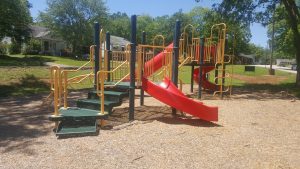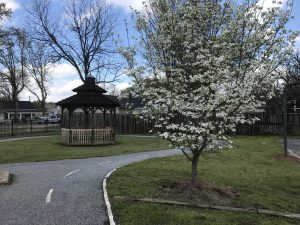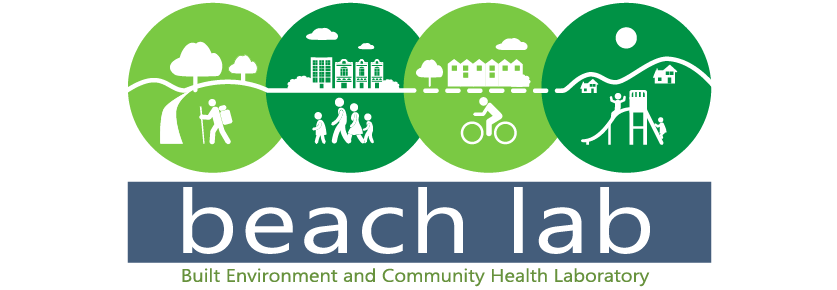| Examining Changes in Disparities in Park Availability, Features, and Quality Across Greenville County, SC |
Background
 Parks are acknowledged as important settings for physical activity and health, especially in low-income areas where other accessible, low-cost resources may not be available. Generally, persons from lower income and minority backgrounds exhibit lower physical activity levels. This may be partly explained by growing evidence showing that parks and other recreation facilities are often less common in low income and racially-diverse neighborhoods. However, some authors have reported discrepant findings and few such studies have considered the actual content of parks. Further, little research has been done on park content change over time, particularly with emphasis on improvements in park equity. Thus, more research is needed to fully assess access to quality park environments and potential park improvements in low income and high minority areas. This has been identified as an important environmental justice issue for public health. Parks are acknowledged as important settings for physical activity and health, especially in low-income areas where other accessible, low-cost resources may not be available. Generally, persons from lower income and minority backgrounds exhibit lower physical activity levels. This may be partly explained by growing evidence showing that parks and other recreation facilities are often less common in low income and racially-diverse neighborhoods. However, some authors have reported discrepant findings and few such studies have considered the actual content of parks. Further, little research has been done on park content change over time, particularly with emphasis on improvements in park equity. Thus, more research is needed to fully assess access to quality park environments and potential park improvements in low income and high minority areas. This has been identified as an important environmental justice issue for public health.
|
| This study was funded by the Piedmont Health Foundation in Greenville, SC as well as the Centers for Disease Control and Prevention through a Partnerships to Improve Community Health award to LiveWell Greenville (award number 1U58DP005588-01). |
Study Objective
 This study examined whether the availability, features, and quality of parks were equitably distributed across Greenville County according to median household income and percent racial/ethnic minority in 2013 and 2017. Further, this study assessed if inequities by income and race/ethnicity improved in availability, features, and quality of parks over a four-year period. This study examined whether the availability, features, and quality of parks were equitably distributed across Greenville County according to median household income and percent racial/ethnic minority in 2013 and 2017. Further, this study assessed if inequities by income and race/ethnicity improved in availability, features, and quality of parks over a four-year period.
|
Methods
All census block groups (n=255) in Greenville County, SC were included in the study. Data from the U.S. Census Bureau’s American Community Survey were used to identify the median household income and the percentage of minority residents (i.e., all residents other than non-Hispanic White persons) for each block group. For both income and percent minority, all block groups were categorized into tertiles (low, medium, high). Parks were enumerated using geographic information systems (GIS) shape files provided by both the City of Greenville and Greenville County. Parks in Greenville County were included in an edited file after an in-person audit if they were deemed useable and publicly accessible. Park availability within block groups was measured using ArcView 10.2 by determining the number of parks and the total area of parks intersecting each block group.
Park features and quality were assessed via the Community Park Audit Tool (CPAT). Trained observers used the CPAT to assess the presence of 14 park facilities (e.g., playgrounds, sports fields, trails) and 23 park amenities (e.g., restrooms, lights, car parking). We compared the total number of individual facilities as well as the average number of amenities across block groups. The condition of park facilities was also measured using the audit tool. Park quality was measured by the average number of quality concerns (e.g., graffiti), aesthetic features (e.g., landscaping), and number of surrounding neighborhood concerns (e.g., poorly maintained properties) per park in the block group.
|
Study Findings
This study adds to an important body of literature examining income and racial/ethnic disparities in access to active living environments. In Greenville County, SC, park availability was equitably distributed across low, medium, and high income areas as well as across block groups that had a low, medium, and high percentage of minority residents.
 In 2013, high minority block groups had more neighborhood concerns in the area surrounding the park compared to low and medium percent minority block groups. In 2017, high minority block groups had more facilities in good condition than low minority block groups, but there were more park quality concerns for high minority block groups compared to low minority block groups. In both 2013 and 2017, high income block groups were more likely to have all facilities in good condition compared to low income block groups, and all levels of income and percent minority residents were similar on park acreage, number of individual facilities, total park amenities, and park quality.In Greenville County and elsewhere, public health and parks and recreation researchers and practitioners should work together to examine policies that contribute to and that might rectify any disparities in access to safe and attractive parks and open spaces. This can ensure a level playing field so that future generations from all backgrounds and neighborhoods may enjoy the health benefits of parks in Greenville County. In 2013, high minority block groups had more neighborhood concerns in the area surrounding the park compared to low and medium percent minority block groups. In 2017, high minority block groups had more facilities in good condition than low minority block groups, but there were more park quality concerns for high minority block groups compared to low minority block groups. In both 2013 and 2017, high income block groups were more likely to have all facilities in good condition compared to low income block groups, and all levels of income and percent minority residents were similar on park acreage, number of individual facilities, total park amenities, and park quality.In Greenville County and elsewhere, public health and parks and recreation researchers and practitioners should work together to examine policies that contribute to and that might rectify any disparities in access to safe and attractive parks and open spaces. This can ensure a level playing field so that future generations from all backgrounds and neighborhoods may enjoy the health benefits of parks in Greenville County.
|
PICH Report
For a copy of the full report, please click here: 2017 PICH Report |
Project Team
For more information about the PICH project, feel free to contact us:
Andrew Kaczynski, PhD
University of South Carolina
atkaczyn@mailbox.sc.edu
Ellen W. Stowe
University of South Carolina
ewstowe@email.sc.edu
Morgan Hughey, MPH
College of Charleston
morganhughey@gmail.com
Sarah B. King
University of South Carolina
sbking@mailbox.sc.edu |

 Parks are acknowledged as important settings for physical activity and health, especially in low-income areas where other accessible, low-cost resources may not be available. Generally, persons from lower income and minority backgrounds exhibit lower physical activity levels. This may be partly explained by growing evidence showing that parks and other recreation facilities are often less common in low income and racially-diverse neighborhoods. However, some authors have reported discrepant findings and few such studies have considered the actual content of parks. Further, little research has been done on park content change over time, particularly with emphasis on improvements in park equity. Thus, more research is needed to fully assess access to quality park environments and potential park improvements in low income and high minority areas. This has been identified as an important environmental justice issue for public health.
Parks are acknowledged as important settings for physical activity and health, especially in low-income areas where other accessible, low-cost resources may not be available. Generally, persons from lower income and minority backgrounds exhibit lower physical activity levels. This may be partly explained by growing evidence showing that parks and other recreation facilities are often less common in low income and racially-diverse neighborhoods. However, some authors have reported discrepant findings and few such studies have considered the actual content of parks. Further, little research has been done on park content change over time, particularly with emphasis on improvements in park equity. Thus, more research is needed to fully assess access to quality park environments and potential park improvements in low income and high minority areas. This has been identified as an important environmental justice issue for public health. This study examined whether the availability, features, and quality of parks were equitably distributed across Greenville County according to median household income and percent racial/ethnic minority in 2013 and 2017. Further, this study assessed if inequities by income and race/ethnicity improved in availability, features, and quality of parks over a four-year period.
This study examined whether the availability, features, and quality of parks were equitably distributed across Greenville County according to median household income and percent racial/ethnic minority in 2013 and 2017. Further, this study assessed if inequities by income and race/ethnicity improved in availability, features, and quality of parks over a four-year period.